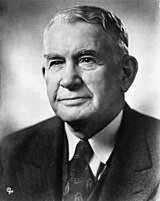United States Senate elections, 1940
|
|
|||||||||||||||||||||||||||||||||||||||||||||||||||||||||||||||||||||||||||
|
|||||||||||||||||||||||||||||||||||||||||||||||||||||||||||||||||||||||||||
|
|||||||||||||||||||||||||||||||||||||||||||||||||||||||||||||||||||||||||||
|
|
|||||||||||||||||||||||||||||||||||||||||||||||||||||||||||||||||||||||||||
|
Republican hold
Republican gain
Democratic hold
Democratic gain
Progressive hold
|
|||||||||||||||||||||||||||||||||||||||||||||||||||||||||||||||||||||||||||
|
|||||||||||||||||||||||||||||||||||||||||||||||||||||||||||||||||||||||||||
The United States Senate elections of 1940 coincided with the election of Franklin D. Roosevelt to his third term as President.
Although Roosevelt was re-elected, support for his administration had dropped somewhat after eight years, and the Republican opposition gained three seats from the Democrats. However, the New Dealers regained firm control of both the US House of Representative and US Senate because Progressives dominated the election. The Minnesota Farmer–Labor Party also disappeared from the Senate, as Henrik Shipstead joined the Republican party and Ernest Lundeen had died during the preceding term.
Incumbent John G. Townsend, Jr. (R-DE) was defeated by a Democrat, but Republicans defeated two incumbents James M. Slattery (D-IL) and Sherman Minton (D-IN), and took two open seats in Nebraska and Ohio.
...
Wikipedia



